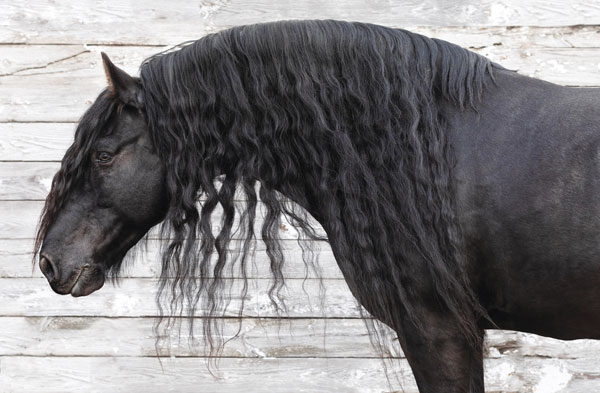
If you love the Baroque and the majestic, the romantic and the noble, then one breed of horse should really strike your fancy: the Friesian horse. Once the mount of medieval knights, this striking black horse looks like it stepped out of a fairy tale.
Sometime before the 17th century, Arabian blood was introduced to the native horses of Friesland, a province in the northern reaches of the Netherlands. This “light horse” blood, combined with the genes of Spanish Andalusian horses also brought to the area, created a unique horse with high knee action. The result was a flashy mount that was heavy enough to carry armored warriors into battle.
It wasn’t long before word of this Friesian horse breed spread throughout Europe. Horsemen began importing Friesian stallions from the Netherlands into their countries for use in local breeding programs.

Meanwhile, in the 1600s a group of Dutch settlers came to North America along with their Friesian horses. The settlers called their colony New Amsterdam, and lived there for 50 years before the British took control of the area and renamed it New York. The English colonists began crossbreeding their British horses to the Dutch Friesians that were already there. Some experts believe the Morgan and the Canadian Horse are two New World breeds that resulted from these crossings, saying these breeds owe their existence to the Friesian.
The purebred Friesian horse did not exist again in America until hundreds of years later. In the 1970s, Americans who had discovered the Friesian breed while visiting Europe began importing individual horses to the U.S.
In 1983, the Friesian Horse Association of North America (FHANA) was formed as the only recognized North American representative of the Friesch Paarden-Stamboek (FPS), the original studbook for Friesian horses in the Netherlands. The Koninklijke Vereniging “Het Friesch Paarden-Stamboek” (KFPS) has registered Friesian horses since 1879.
Modern Friesians
Today, 14,000 Friesians are currently registered in the United States. American breeders follow the same criteria as their Dutch counterparts in order to the keep the Friesian horse breed pure.

The quality of American Friesian foals and adults are determined by an FPS judge from the Netherlands at annual regional events called keurings, which is Dutch for “inspections.” At each keuring, horses are judged on their movement and conformation. Horses that pass the keuring are allowed to enter the Royal Friesian Studbook.
Friesians are flashy horses, and they stand out in every discipline where they appear. Friesians in the U.S. are currently being shown in western pleasure, show driving, dressage driving, ridden dressage, saddle seat and English pleasure.
In the past few years, Friesians have proven themselves to be particularly competitive in the dressage arena, with a number of horses finding success at the FEI levels. The breed made its world championship debut in dressage at the 2014 FEI World Equestrian Games in Normandy, France, when the stallion Adelprag Anders 451 represented the country of South Africa.
As stunning as Friesians are to look at, they are most exceptional when it comes to temperament. Both gentle and willing, Friesians not only make great show horses, they make wonderful equine companions. Although this impressive-looking horse might seem fancy for ordinary trail riding, many Friesian horse owners find this breed to be perfect company for a day out on the trail.
Fast Facts About the Friesian HorseHeight: 15.2 to 16 hands on average, although they can be taller or shorter. Color: Black Overall Appearance: Relatively short head with small, alert ears, large eyes and wide nostrils. High-set neck slightly arched at the crest. Well-developed withers, and slightly sloping croup. Long, heavy mane and tail. Associations: |
This Friesian horse breed profile appeared in the August 2020 issue of Horse Illustrated magazine. Click here to subscribe!





